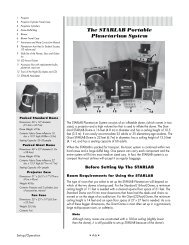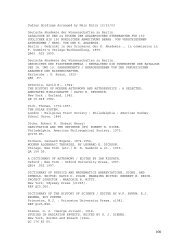K-6 Activities - Dudley Observatory
K-6 Activities - Dudley Observatory
K-6 Activities - Dudley Observatory
Create successful ePaper yourself
Turn your PDF publications into a flip-book with our unique Google optimized e-Paper software.
Objective<br />
Sunrise and Sunset Position,<br />
Activity 6-2<br />
The student should be able to describe the relative changes in the sunrise and sunset<br />
positions and times over a one year period.<br />
Background<br />
If you got up early enough to watch the sunrise one morning each week for a<br />
whole year, you would notice an interesting pattern. On September 22 (autumnal<br />
equinox) the sun would rise due east; on December 21 (winter solstice) the sun<br />
rises from its southern-most position; on March 20 (vernal equinox) the sun again<br />
rises due east; and on June 21 (summer solstice) the sun rises from its northernmost<br />
position. If you made accurate observations from the time the sun rose due<br />
east, then moved southward, then northward, then back due east, you would find<br />
that 365 days had passed.<br />
The yearly changes in the stars which are visible are sometimes difficult for children<br />
to understand. Remember that it is night when we are on the side of earth away from<br />
the sun, and we can only see those stars which are above us at night. Consider two<br />
times of the year; six months apart — for example, December 21 and June 21. The<br />
earth is on opposite sides of its orbit on these two dates. When you look into the sky<br />
on these two nights you are looking in opposite directions and see a different part of<br />
the sky. Therefore, the stars seen in the southern sky will change throughout the year.<br />
For the same reason, the stars which are near the North Star will appear to make a<br />
complete circle around it each year.<br />
Procedure<br />
• Using the Starfield Cylinder and optional ecliptic slide projector mount, set up<br />
for approximately September 22 by removing the plug covering the September<br />
sun position on the Starfield Cylinder. Repeat the procedure when observing<br />
in December, March and June. Project the sun due east just above the horizon.<br />
Rotate the cylinder to about December 22 and show the sun rising from its southern-most<br />
position along the ecliptic. Again rotate the cylinder to about March<br />
20 and show the sun rising due east. Rotate the cylinder to about June 21 and<br />
show the sun rising at its most northern position. Finish the activity by moving the<br />
cylinder once more to September 22 and show the sun rising due east.<br />
• Review the procedure for locating the North Star (Polaris) and have the students<br />
follow the apparent motion of the circumpolar constellations as they move<br />
around Polaris. Be sure to relate the movement to the rotation of the earth (one<br />
complete turn of the cylinder equals 24 hours).<br />
• Have the students face the eastern horizon and locate a star or constellation. Use<br />
a star and planet finder to help. For example: if you observe the night sky on November<br />
15 at 9:00 p.m., the constellation, Orion, will be in the eastern sky. The<br />
students should follow the constellation as it rises and sets. This motion should be<br />
related to the rotation of the earth.<br />
Extension <strong>Activities</strong><br />
Have the students plot the path of the sun rising throughout a year’s time on a worksheet<br />
that has the horizon drawn on it. Use the sunrise-sunset time schedule to relate<br />
the days getting shorter and shorter and then longer and longer to the above activity<br />
showing the different positions of the sun rising at different times of the year.<br />
Materials<br />
• STARLAB Portable Planetarium<br />
• Projector<br />
• Starfield Cylinder<br />
• horizon worksheet (paper with<br />
horizon drawn on it)<br />
Optional<br />
• ecliptic slide projector mount<br />
• B–71 • K–6 <strong>Activities</strong>





